Description
This animal must have been very similar in shape and size to today's giant armadillo ( Priodontes maximus ); it is likely that the largest species of Vassallia maxima could have exceeded one meter in length. Like all pampatheres, Vassallia was also equipped with an armor consisting of osteoderms articulated with each other to form two rigid structures, one anterior and one posterior, and a few bands of movable osteoderms that allowed partial movement of the back. Vassallia was very similar to another pampathere, Kraglievichia from which it differed mainly in some dental features (the teeth had a somewhat simpler structure) and bony plates, which had a main figure with a slightly elevated central area.
A study carried out on the dentition and morphology of jaw and mandible of Vassallia indicated that this animal possessed some features comparable to those of some mammalian ungulates, such as wide and flattened mandibular condyles, non-fused mandibular symphysis, expanded angular processes, posteriorly extended tooth row, open root teeth, mesial teeth with transverse striations, elongated and gradually arranged distal teeth. Vassallia also, unlike other pampatheres such as Holmesina', possessed on the occlusal surfaces of the teeth a central island of dentin resistant dentin that functioned as an ectoloph, which is also present in ungulates.

Xenarthra is a major clade of placentalis gay mammals native to the Americas. There are 31 living species: the anteaters, tree sloths, and armadillos. Extinct xenarthrans include the glyptodonts, pampatheres and ground sloths. Xenarthrans originated in South America during the late Paleocene about 60 million years ago. They evolved and diversified extensively in South America during the continent's long period of isolation in the early to mid Cenozoic Era. They spread to the Antilles by the early Miocene and, starting about 3 Mya, spread to Central and North America as part of the Great American Interchange. Nearly all of the formerly abundant megafaunal xenarthrans became extinct at the end of the Pleistocene.

Cingulata, part of the superorder Xenarthra, is an order of armored New World placental mammals. Dasypodids and chlamyphorids, the armadillos, are the only surviving families in the order. Two groups of cingulates much larger than extant armadillos existed until recently: pampatheriids, which reached weights of up to 200 kg (440 lb) and chlamyphorid glyptodonts, which attained masses of 2,000 kg (4,400 lb) or more.

Glyptotherium is a genus of glyptodont that lived from the Early Pliocene, about 4.9 million years ago, to the Early Holocene, around 7,000 years ago, in the United States, Mexico, Guatemala, Costa Rica, Honduras, El Salvador, Panama, Venezuela, and Brazil. The genus was first described in 1903 by American paleontologist Henry Fairfield Osborn with the type species being, G. texanum, based on fossils that had been found in the Pliocene Blancan Beds in Llano Estacado, Texas, USA. The genus has since been discovered in many more fossil sites. Another species, G. cylindricum, was named in 1912 by fossil hunter Barnum Brown on the basis of a partial carapace, teeth, and several additional fossils that had been unearthed from the Pleistocene deposits in Jalisco, Mexico.
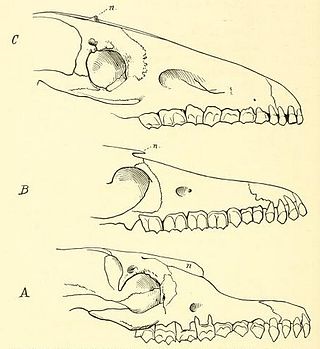
Scalabrinitherium is an extinct genus of mammals of the family Macraucheniidae. Fossils of this animal were found among the fossils of prehistoric xenarthrans in the Ituzaingó Formation of Argentina.

Pampatheriidae is an extinct family of large plantigrade armored armadillos related to extant armadillos in the order Cingulata. However, pampatheriids have existed as a separate lineage since at least the middle Eocene Mustersan age, 45 to 48 million years ago. Pampatheres evolved in South America during its long period of Cenozoic isolation. Although widespread, they were less diverse and abundant than the armadillos. Holmesina spread to North America after the formation of the Isthmus of Panama as part of the Great American Interchange. They finally disappeared on both continents in the end-Pleistocene extinctions, about 12,000 years ago.

Hoplophorus is an extinct genus of glyptodont, a subfamily of armadillos. The only confidently known species was H. euphractus, found in Pleistocene deposits in Brazil, though fossils possibly from another species are known from Bolivia.

Glyptodon is a genus of glyptodont that lived from the Pleistocene, around 2.5 million years ago, to the Early Holocene, around 11,000 years ago, in Argentina, Uruguay, Paraguay, Bolivia, Peru, Brazil, and Colombia. It was the first named extinct cingulate and is the type genus of Glyptodontinae, and, or, Glyptodontinae. Many species have been named for the genus, though few are considered valid, and it is one of, if not the, best known genus of glyptodont. Hundreds of specimens have been referred to the genus, but the holotype, or name specimen, of the type species, G. clavipes, was described in 1839 by notable British paleontologist Sir Richard Owen. The holotype used by Owen is a chimera of fossils from 3 different localities, including a molariform used for the name of the genus that actually belongs to Panochthus, making it a species inquirenda.

Holmesina is a genus of pampathere, an extinct group of armadillo-like creatures that were distantly related to extant armadillos. Like armadillos, and unlike the other extinct branch of megafaunal cingulates, the glyptodonts, the shell was made up of flexible plates which allowed the animal to move more easily. Holmesina species were herbivores that grazed on coarse vegetation; armadillos are mostly insectivorous or omnivorous.
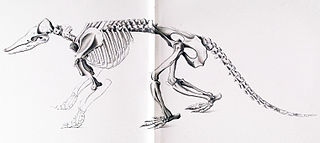
Stegotherium is an extinct genus of long-nosed armadillo, belonging to the Dasypodidae family alongside the nine-banded armadillo. It is currently the only genus recognized as a member of the tribe Stegotheriini. It lived during the Early Miocene of Patagonia and was found in Colhuehuapian rocks from the Sarmiento Formation, Santacrucian rocks from the Santa Cruz Formation, and potentially also in Colloncuran rocks from the Middle Miocene Collón Curá Formation. Its strange, almost toothless and elongated skull indicates a specialization for myrmecophagy, the eating of ants, unique among the order Cingulata, which includes pampatheres, glyptodonts and all the extant species of armadillos.

Neosclerocalyptus was an extinct genus of glyptodont that lived during the Pliocene, Pleistocene, and Holocene of Southern South America, mostly Argentina. It was small compared to many Glyptodonts at only around 2 meters long and 360 kilograms.
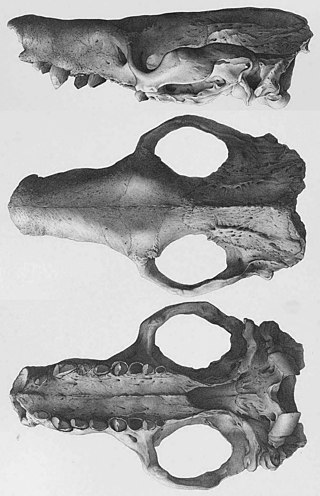
Macroeuphractus is a genus of extinct armadillos from the Late Miocene to Late Pliocene of South America. The genus is noted for its large size, with Macroeuphractus outesi being the largest non-pampathere or glyptodont armadillo discovered, as well as its specializations for carnivory, unique among all xenarthrans.
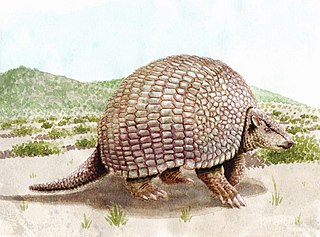
Pampatherium is an extinct genus of xenarthran that lived in the Americas during the Pleistocene. Some species went extinct right at the Pleistocene-Holocene border.
Kraglievichia is an extinct genus of cingulate belonging to the family Pampatheriidae. It lived from the Late Miocene to the Early Pliocene, and its fossilized remains were discovered in South America.
Machlydotherium is an extinct genus of cingulate of uncertain systematic affinities, perhaps belonging to the Pampatheriidae. It lived from the Middle Eocene to the Early Oligocene, and its fossilized remains were found in South America.

Scirrotherium is an extinct genus of pampatheres, a family of herbivorous cingulates, related to the similar but smaller modern armadillos, and with the now extinct glyptodonts, well-known from their shell-like armor. Its scientific name is derived from the Greek prefix "skiros-", "cover", and the suffix "-therion, "beast", while the name of the type species, hondaensis, honors the town of Honda, in the Tolima Department of Colombia. Scirrotherium is one of several genera of xenarthrans found in the La Venta fauna, dated from the Middle Miocene.
Neoglyptatelus is an extinct genus of xenarthran, belonging to the order Cingulata. It lived from the Middle to the Late Miocene, and its fossilized remains are found in South America.

Proeutatus is an extinct genus of xenarthran, belonging to the order Cingulata. It lived during the Early Miocene, and its fossilized remains were discovered in South America.
Glyptatelus is an extinct genus of glyptodont. It lived from the Late Eocene to the Middle Oligocene in what is now Argentina and Bolivia.
Dasypus neogaeus is an extinct species of armadillo, belonging to the genus Dasypus, alongside the modern nine-banded armadillo. The only known fossil is a single osteoderm, though it has been lost, that was found in the Late Miocene strata of Argentina.
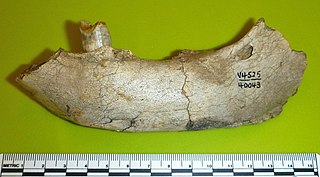
Magdalenabradys is an extinct genus of mylodontid ground sloths that lived during the Middle Miocene and Early Pliocene of what is now Colombia and Venezuela. Fossils have been found in the Villavieja Formation of the Honda Group in Colombia, and the Codore and Urumaco Formations of Venezuela.

















